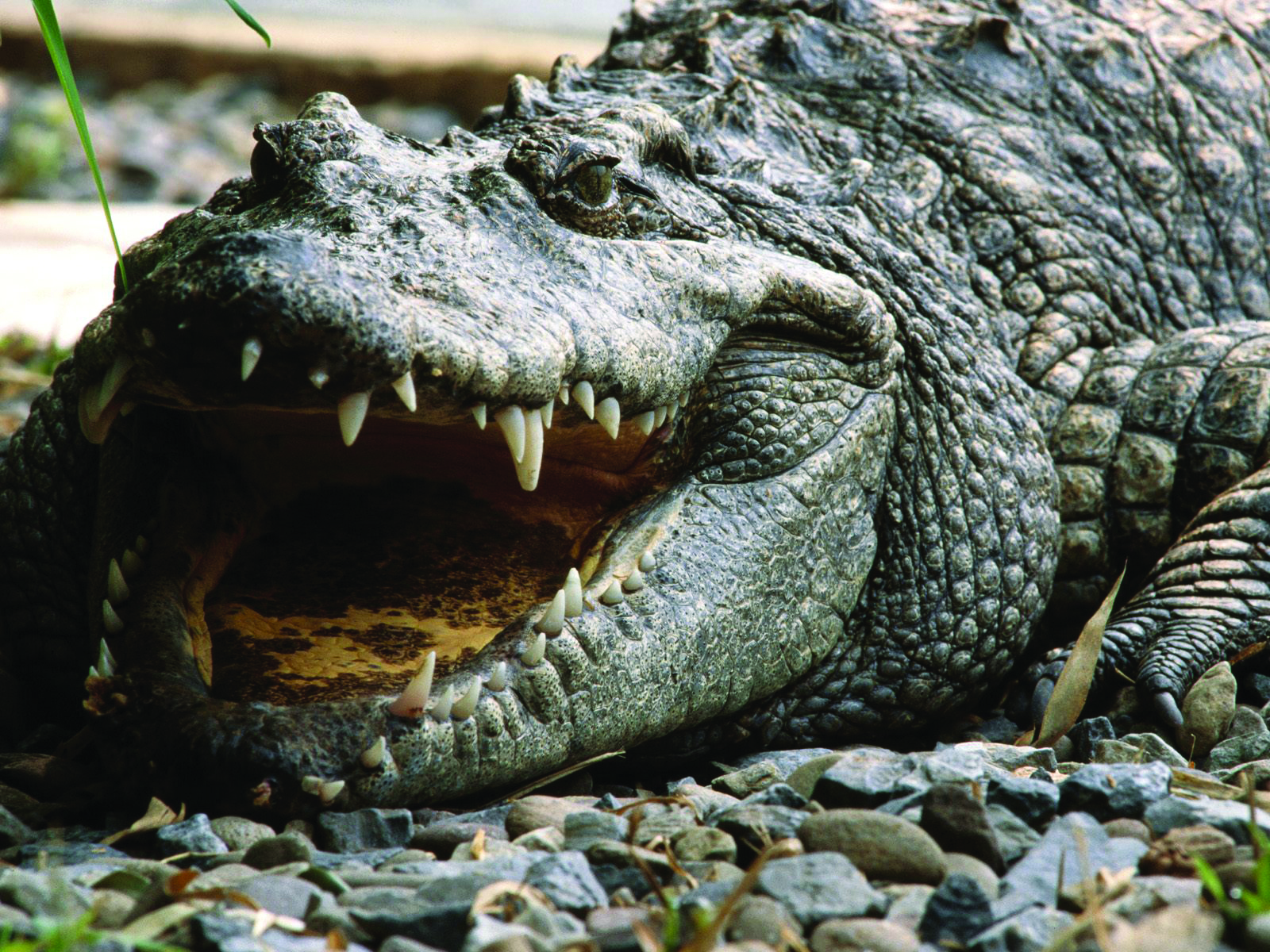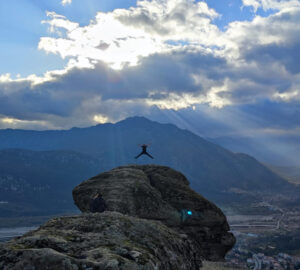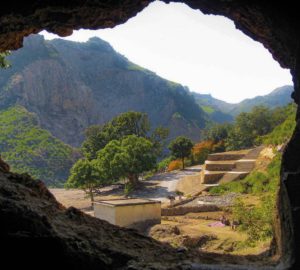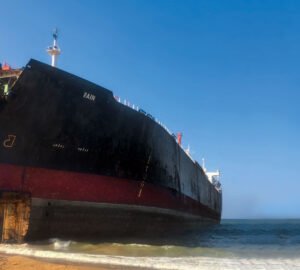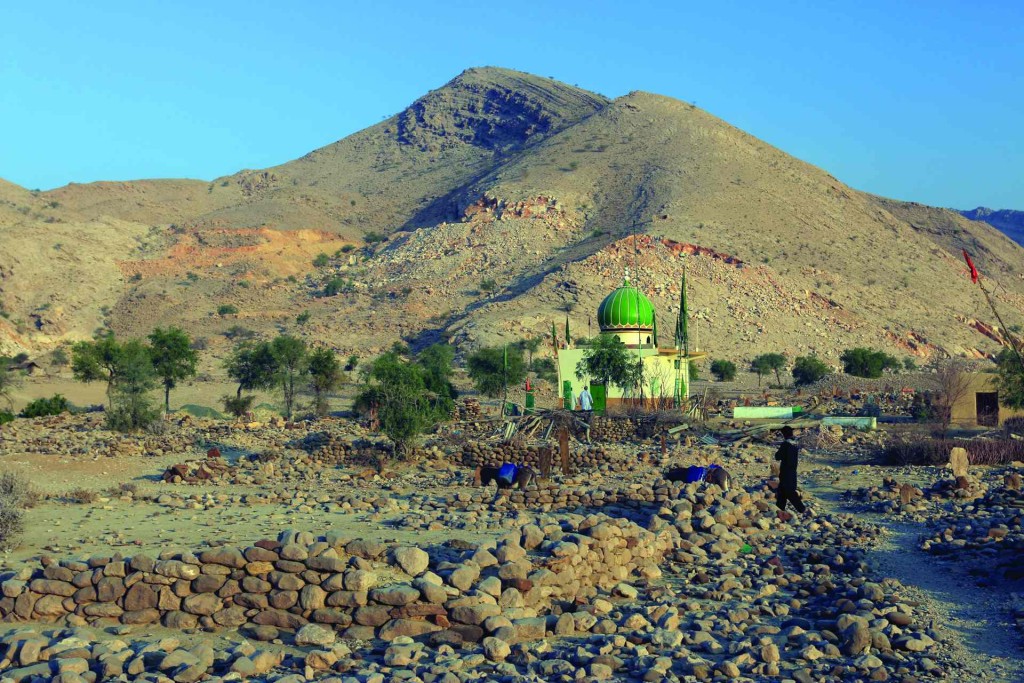 In February 1987, my friend Maqbool Abbas and I trekked up the Hub River from the seaboard to its source. En route, we had an overnight at Ari Pir, north of Dureji in Lasbela district of Balochistan. It was then not known who this saint was except that he lived in a time ‘long before the grandfathers’. The burial was an unpretentious whitewashed sepulchre with a swaddling of greens sheets forming a sort of turban for the headstone. There was no dome above.
In February 1987, my friend Maqbool Abbas and I trekked up the Hub River from the seaboard to its source. En route, we had an overnight at Ari Pir, north of Dureji in Lasbela district of Balochistan. It was then not known who this saint was except that he lived in a time ‘long before the grandfathers’. The burial was an unpretentious whitewashed sepulchre with a swaddling of greens sheets forming a sort of turban for the headstone. There was no dome above.
Here the Saruna River coming down from the northwest meets the bigger Hub. As it breaks out of its tight rocky gorge, the Saruna broadens out to form a lovely emerald tarn which, so I was told, was more than twenty metres deep and alive with crocodiles. On that long ago February afternoon, after we had watched the reptiles sunning themselves on a sandbank, Ahmed the inn keeper told us the story: those accused of thievery were pitched into the lake. And such was the divinity of the crocs that only the thief was attacked and devoured by the crocs. The innocent could thrash around all they wanted and yet remain unmolested by the brutes. This beastly prescience was attributed to the power of Ari Pir.
I returned sixteen years later. The grave had a domed structure and some makeshift huts served as accommodation for pilgrims. Ahmed was replaced by another man and the story was that Ari was the son of Mahmud the robber king of Ghazni. He came here to fall in love with the pretty daughter of the king of Saruna. But the king did not quite take to the ogler and had him banished. The saint cursed the land; the river dried out, agriculture died and verdant Saruna turned desert.
A great and pernicious saint, I thought. And all my life I had laboured under the notion that saints were supposed to be benign and full of the milk of human kindness.
This time around at Ari Pir, I was with my friends Aziz Jamali and Akmal. We overnighted at Dureji at the Bhootani home. In 1987, Maqbool and I had called at this home to meet Saleh Bhootani and seek his permission for travel in his chiefdom. This time, it was his younger brother Aslam, who is well-known for his tenures in the Balochistan assembly. When Aziz introduced us, Aslam observed that I had been to his home before.
This was something I had never expected for who would remember a barely known writer from three decades before. Says a lot for Aslam, I suppose. Even more surprising, he seemed to know of much of my work. And, best of all, Aslam Bhootani is a first-class and very lavish host. As for Dureji, in his years of power he has transformed the little village of 1987 into a lovely little modern town that could shame many parts of Lahore.
On the morrow we drove to Ari Pir. Accommodation for pilgrims was now a concrete shed next to a mosque. The untainted, earthy picturesqueness of this wild and beautiful country of all those years ago was somewhat faded. A gated weir has been built across the lower end of the lake to raise water level. To my eye however, the lake seemed just the way I had first seen it back in 1987. Even in the early morning cool, we did not see any crocs sunning themselves. But there was a family of devotees lounging around the pilgrims’ shed waiting for their goat to be slaughtered. Part of the meat was to be cooked and consumed by the pilgrims; the rest offered to the crocs to accept the devotees’ prayers.
It is believed that devotees whose offerings are accepted by the crocodiles – colloquially and more appropriately referred to as ‘mor sahib’ – are fortunate for their wishes will come true. The khalifa, seventyish with a skull cap and silver whiskers, came around walking with a tapping cane and an officious air to supervise the butchering. Occasionally instructing the pair cutting up the animal, he played supremely aloof as I photographed him. Taking a shoulder and the offal he walked with us and the pilgrims in tow to the spot where the Saruna just begins to widen to form the lake and sat down on a waterside rock.
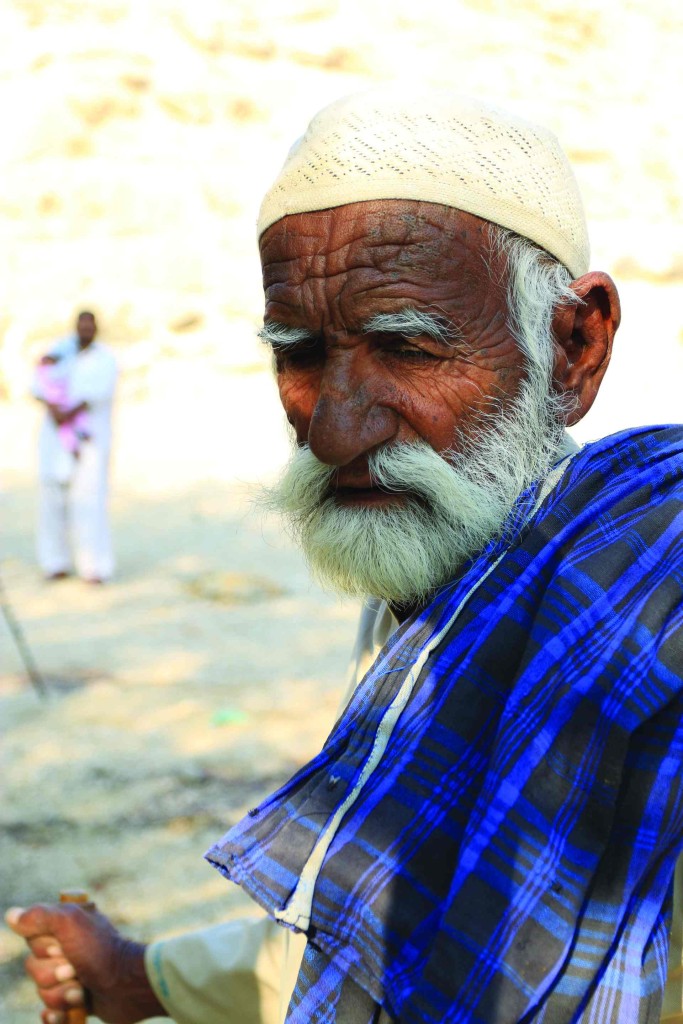 ‘Ao mor sahib, ayo!’ the man called out with his voice reverberating off the burnished walls of the Saruna gorge. Repeated calls made for some bustle in the reeds on the far bank right across us. And then the beast came into full view as it slithered into the green waters. Almost three metres long and apparently rather well-fed, mor sahib wagged its tail to propel itself into the middle of the stream. The khalifa tossed the shoulder into the water and the beast grabbed it quickly before going under.
‘Ao mor sahib, ayo!’ the man called out with his voice reverberating off the burnished walls of the Saruna gorge. Repeated calls made for some bustle in the reeds on the far bank right across us. And then the beast came into full view as it slithered into the green waters. Almost three metres long and apparently rather well-fed, mor sahib wagged its tail to propel itself into the middle of the stream. The khalifa tossed the shoulder into the water and the beast grabbed it quickly before going under.
Two other crocs, the bigger one leading, were unhurriedly gliding in from the opposite direction. The khalifa tossed in the offal to land about a couple of metres from the leading snout. The croc slowed down and came up to the offal as if on idling engine. With its snout nudging the bloated gizzard it stopped and remained motionless.
Meanwhile, mor sahib, the star of the day, surfaced and with two fearsome chomping motions swallowed the shoulder, flesh, grist and bone. Loud cries of ‘mashallah, mashallah, alhamdolilla!’ went up just as they do when a newborn infant burps after its first feed. The pencil-thin bearded Karachi man told me that when mor sahib exhibits his act of feeding, it is signal that the petitioner’s prayer has been heard. The idiot did not know that crocodiles do not swallow underwater; that they have to surface to swallow. But then superstitious belief has never been famous for sensibility.
We waited to see how the laggard of a croc who got the offal for his tardiness would eat his meal. But for a full thirty minutes it remained motionless, its nose glued to the gizzard. Aziz, who has a sense of humour as sharp as we believe only Lahoris can have, said the beast was finicky about its meal and they might have to butcher another goat for it. But there were no more goats to be had.
‘Well, we have no more goats but we could just as well cut up good old Akmal and pitch him into the water for the spectacle,’ said Aziz. ‘But unfortunately, I cannot spare him today.’
Aziz and Akmal who had earlier been inside the tomb, said there was now a sign in the building that said this was the burial site of Mohammad bin Haroon who had come hither with Mohammad bin Qasim. Now, bin Haroon was the governor of Kech (Turbat) at the time of the invasion led by bin Qasim and was ordered by Hujjaj bin Yusuf to accompany the invading force to Sindh. However, when the army arrived at Lasbela, bin Haroon went down with the ague and passed away. Just outside Lasbela town, to the northwest, there sits the tomb of that man alias Ari Pir, a fine example of early Muslim architecture in Balochistan.
Ari appears to be a common name or a common corruption for a name. We have Ari Jam, the medieval king of Kech whose son Punnu lost his heart to the beauteous Sassui of Bhambore. We have Ari in Lasbela and we have Ari on the Saruna. As well as all these, there is an Ari Pir by the village of Jhangara near Sehwan. I have not worked out if it is actually a corruption of Haroon, as they say, or of Aali. Whatever the case, between my last visit in 2003 and now, the makers of the legend of this Ari Pir have become acquainted with bin Haroon. What they do not know is that the man gave up his ghost in Lasbela, never getting this far on a trail that did not head for Debal, the Arab army’s first objective.
What is interesting is the way the story of this saint altered over the past three decades of my three visits. What hasn’t changed is the status of the shrine. In 1987, innkeeper Ahmed was very confident that within years Ari Pir was going to be as great a festival as the nearby shrine of Bilawal Noorani. But that has not come to pass: Ari Pir remains a modest cousin to that shrine. One wonders what the story will finally be if I am able to return to Ari Pir in, say, thirty years from now.
Whatever the yarn may be, one change that is inevitable is that the beautiful, virgin topography around Ari Pir will have been ravaged. For a couple of years past, contractors have set up extraction of limestone from these hills. Though at a small scale for the time being, it is only bound to grow. In a few years, these lovely panoramas will be ravaged with wounds inflicted by man’s insatiable greed for lucre and his disregard for the natural world.


